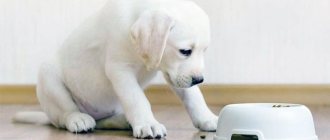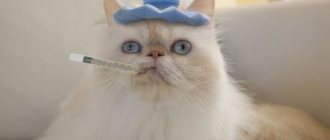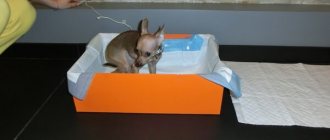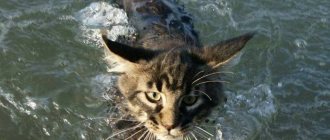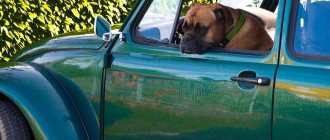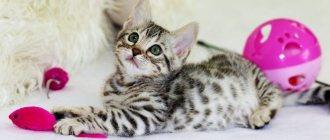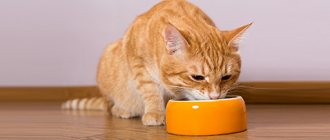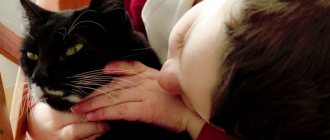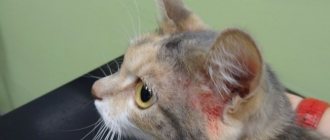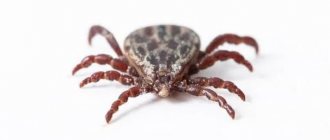Let's understand the reasons
- Fact:
Dehydration deteriorates the general condition of the kitten’s body, as well as its appearance. - Fact 2:
There is no reason to worry if the animal eats a lot of natural food containing moisture - Fact 3:
If a bowl or other container with water is in a dirty place, the cat, as a clean animal, will neglect to drink - Fact 4:
Many animals make their recovery easier by refusing food and water.
After the arrival of a little pet at home, the life of its owner is immediately filled with new worries. It is necessary to think not only about education, hygienic care, treatment and feeding of the animal, but also about its drinking regime. New cat owners are sometimes surprised to discover that their animal does not drink water at all, although it has an excellent appetite. Let's figure out why this happens and how to help the kitten.
Harm from lack of fluid in a cat's body
Concerns about possible dehydration in your pet are not unfounded. A blow to the body of a child who does not drink water can be urolithiasis. There may also be other consequences, resulting in serious pathologies leading to death. Dehydration deteriorates the general condition of the kitten’s body, as well as its appearance. Lack of water can lead to a decrease in the quality of the coat, loss or damage to the whiskers. In addition, the lack of water in the baby’s diet will lead to thickening of the lymph and improper water-salt metabolism.
Moreover, if a small animal eats dry food and does not drink water at all, this can further enhance the negative effect of dehydration. The result of such a development of the situation can be not only diseases, but also a delay in the mental and physical development of the kitten. Even if he does not want to drink, a caring owner should teach the animal not to leave a bowl of water untouched.
What is the problem: main reasons
If a pet drinks only milk and eats well, but constantly refuses to quench its thirst, then this does not always signal pathological conditions. Perhaps the pet simply doesn’t like water or doesn’t like the one its owners give it. And also, for example, small cats that were fed breast milk or from a nipple, and are not accustomed to drinking, may be unable to independently quench their thirst from a bowl for a month or even more. There are other reasons why a cat does not drink water:
- Low quality dishes. Owners, wanting to save money on cat products, sometimes buy very bad products, which are sometimes made of unpleasant-smelling plastic. Seals and adults often refuse to drink from such a bowl or scoop it up with their paw.
- The cat's inability to drink water from the bowl. To the surprise of people, not all pets have this skill, so sometimes it is necessary to spend time and teach the cat to drink or provide it with another source.
- Unpleasant smell of water. If a tap product is used, it may contain large amounts of chlorine. In this case, owners rarely manage to force their pet to drink. It is recommended to install a filter or use bottled water.
- Dirty bowl. If the drinking vessel is not washed on time, then the pet can quench its thirst directly from the tap and other sources.
- Pathological condition. When a cat does not eat or drink, this may be a signal of the development of a disease. If the pet is rejected, it may cause diarrhea, vomiting, weakness and other symptoms.
Veterinarians advise buying water dishes made of ceramics, since such a bowl does not have an unpleasant odor and is easy to clean.
When is there no reason to worry?
A very small kitten has not yet transitioned to an adult lifestyle, and therefore receives all the necessary substances from the milk of its mother cat. Milk is both food and drink for the baby, so very young animals should not be persistently given water.
There is also no reason to worry if the animal eats a lot of natural food containing moisture. Such suitable foods include dairy products, eggs, buckwheat and other cereals. If your pet eats canned food, then it can also get enough water from it.
Video “Lazy cat drinks water lying down”
Watch a video in which a cat drinks water in a very funny way.
Was this article helpful?
Thank you for your opinion!
The article was useful. Please share the information with your friends.
Yes
No
X
Please write what is wrong and leave recommendations on the article
Cancel reply
Rate the benefit of the article: Rate the author ( 3 votes, average: 4.33 out of 5)
Discuss the article:
Why doesn't the kitten drink?
Experts identify several reasons why a small animal refuses water:
- The baby is very small . He only recently learned to get everything he needs from his mother. Natural instincts helped him learn to consume food, but the cat still cannot lap up water. If the mother cat lives next to him, the baby gradually learns to drink by looking at his mother. If she is in a different place, the owner will have to help the little pet by offering him a saucer of water and gently guiding him.
- If a bowl or other container with water is in a dirty place , the cat, as a clean animal, will neglect to drink. Almost all cats are not averse to drinking from a tap or bucket of clean water. To stop such actions, you need to provide your pet with a neat watering hole.
- The water container has an unpleasant odor or is very bright in color. Cats are gentle creatures, so in this case you will have to use trial and error to find the appropriate option. The solution may be to purchase a neutral-colored ceramic vessel.
- The animal may not appreciate the smell of chlorine in tap water. You should install a filter or use bottled water (usually a little is required).
- The kitten is sick. Many animals make recovery easier by refusing food and water. Sometimes the animal simply loses its appetite. At the same time, some animals continue to eat but refuse liquids. Alarming symptoms of ill health are vomiting, stool disturbances, and decreased activity of the pet. If these signs appear in parallel with refusal of water, you should contact your veterinarian.
What kind of water is considered healthy for a pet?
So, you learned about the amount of water, now let's look at it - is all water good for cats?
Water can be boiled, distilled, raw, tap, bottled.
During the boiling process, most of the beneficial substances in water are destroyed. Not only is it called “dead,” scientists have proven that it can provoke urolithiasis, as well as become a source of dangerous viruses and bacteria entering the body.
Distilled water does not benefit the body.
Tap water contains a lot of bacteria, microorganisms, salts, metals, and chloride compounds, which are unlikely to be beneficial for a cat, especially a small one.
Spring or well water often contains more than normal nitrates, salts and iron, and they are known to cause serious diseases of the urine and reproductive system.
What remains is bottled water. It is truly considered the most useful and high quality. But buying water from underground sources is not cheap, so not everyone can afford it.
The easiest way is to give your baby tap water, but to avoid health problems, experts recommend filtering it, or at least settling it.
How can you teach him to drink?
The easiest way to awaken your baby's thirst is to keep him busy with active games. After an active pastime, the animal loses some of the moisture in the body, so the chances of success in accustoming to a bowl of water increase.
If the animal still resolutely refuses to drink, you can use a syringe filled with water. It is advisable to place a container of water away from the bowl of food, then the water offered to the cat will remain clean and the pet will be more likely to like it.
Another way is to put water in different parts of the apartment or house. Perhaps in one of the places the animal will be more comfortable drinking - that’s where the permanent bowl is placed. It is also advisable to offer drinks from containers of different colors, sizes and shapes. As a rule, mustachioed pets prefer bowls with a large diameter.
In addition, the owner needs to understand what water temperature the kitten prefers. To do this, you can offer your baby both cold and heated liquids from the same bowl. Some kittens and adult animals love running tap water. If possible, you can leave the tap always on or turn off the water several times a day.
Interesting Facts
The origin of the cat is associated with its African history. It was in Egypt that these animals were revered most of all, they were looked after, kept clean, tidy, and extolled. A weakened craving for water and a feeling of thirst are associated with the remaining need for a small amount of water on a dry continent. But we know how important it is for a cat to drink. Therefore, you need to replace your water balance through drinking or eating.
Every owner wants their cat to be healthy. Satisfying the daily need for water (1.5-2 times more than food intake, especially if it is dry food) helps normalize metabolic processes, prevent stagnation and possible infections of the genitourinary system. Cats love to drink water from fountains, so if your pet actively asks for water from the tap, you can buy such a device for him.
Sometimes cats drink liquids from non-standard containers, such as a bucket, sink or mug. If you have the opportunity to give your pet such a drinking item, fill it with more water and place it in an accessible place. In summer, you can take a wide bowl and leave it on the balcony.
What kind of water to offer a kitten
Animals may have different water preferences, but there are some general rules:
- the water must be clean;
- various odors are not allowed, even those pleasant to humans;
- the bowl should always be accessible; you should not place it in the toilet, bathroom or other locked rooms;
- water needs to be changed regularly;
- It is recommended to first leave tap water to settle or use a filter.
Perhaps it would be convenient for the owner to teach the cat from an early age to drink regular tap water, only poured from the tap. This is not recommended, because such water contains a lot of chlorine and may contain other impurities that are not beneficial for the body.
To attract a kitten to water, some pet owners add a little of the animal's favorite treat - for example, fish. Only a small amount should be used, just to impart a slight aroma.
The dangers of insufficient fluid intake
If a cat doesn't drink enough, it becomes chronically dehydrated. First of all, owners notice problems with the coat - it becomes dull and falls out. Then the urinary system suffers. The urine becomes too concentrated and the salt crystals it contains precipitate. First, “sand” is formed, and then larger stones. Urolithiasis is especially dangerous for males - sand clogs the long and thin urethra, causing urinary retention.
Water is also important for digestion. Chronic dehydration causes constipation. If your pet's poop is hard as pebbles, this is a warning sign.
When dehydrated, your blood becomes thicker and your blood pressure rises. This is especially dangerous for cats with kidney or heart failure.
Too little water...
How to figure out if your kitten has enough water
To understand that the animal has enough fluid for normal functioning, you need to analyze the following points:
- Condition of skin and coat . They should have a healthy appearance, without peeling or bald spots. You can pull back the kitten's scruff - with elastic skin, it will easily return to its previous position, but in a dehydrated kitten, the elasticity of the skin is lost.
- Activity . A healthy animal should be cheerful, especially in childhood.
- Frequency of urination . A healthy animal goes to the toilet 2-3 times a day. The number of approaches to the tray can be determined by how dirty it is.
How about fish?
3. Cats should not be given fish often.
Kittens can be given fish once a week, and adult cats no more than once every two weeks, but it is better to exclude it altogether from the diet of an adult cat. Give the fish boiled and without bones. In case of urolithiasis and other diseases of the urinary system, especially in castrated cats, exclude fish from the diet forever. 4. Mixing natural food and dry food is strictly forbidden. And if you feed a British cat with dry food, then adding natural food (meat, fish, vegetables) to the diet is also prohibited, as this can lead to diseases of the gastrointestinal tract and urinary system in the future.
To digest dry food and natural products in the cat's intestines, different enzymes and a completely opposite acidic environment are required. When these two completely opposite types of feeding are mixed, an imbalance occurs in the cat's stomach, and the liver suffers greatly from this double load. The cat’s intestines react differently and digest dry food and natural food, and simply do not have time to switch from one type of feeding to another, and this is fraught with a bunch of diseases in the future.
In general, the opinions of veterinarians and breeders differ on this matter, and they themselves feed their cats meat and porridge in the morning, and leave dry food in a bowl for the day. But “the facts are clear” and I will not feed my animal according to this scheme.
Reasons for stopping alcohol consumption
There are many reasons why a person stops drinking. Among the most significant are:
- desire to be healthy;
- deterioration of health and development of chronic diseases;
- more attractive appearance for people who do not have problems with alcohol;
- a sober, sharp and unblemished mind, the desire to adequately perceive the surrounding reality;
- high efficiency;
- good attitude at work and impeccable reputation;
- saving money (financial expenses on alcohol always take up a significant share in the budget of an alcohol addict);
- high sexuality, no problems with potency in men or the menstrual cycle in women;
- availability of strength and time (after all, the life of a person in an alcoholic web is guided by one desire - to drink);
- excellent state of mind, cheerfulness;
- healthy atmosphere at home;
- a full, bright and healthy life;
- healthy offspring.
The path to a sober life is very long and difficult. However, a person has a chance to get rid of the addiction by following the advice of doctors. The most important thing for this is to have a strong desire to recover and an iron will.
Why water is important for cats
Water is vital for any living creature. It performs important functions in the body:
- regulates body temperature;
- transports nutrients;
- necessary for digestion of food;
- helps remove toxins from the body;
- supports the functions of internal organs;
- ensures the functioning of enzymes;
- participates in the functioning of muscles, joints, eyes;
- maintains tissue elasticity.
Therefore, it is important to have enough of it in the diet. In animals that consume little fluid, concentrated urine is dark yellow in color with a pronounced odor. At the same time, they rarely go to the litter box. Constipation is also an indirect sign of insufficient fluid intake. This can contribute to the formation of sand and stones in the bladder. And also a lack of fluid can lead to weakening of the body, metabolic disorders and decreased immunity. It is necessary that your pet has unlimited access to water around the clock.
